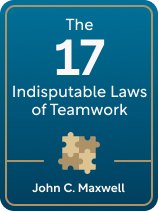

This article is an excerpt from the Shortform book guide to "The 17 Indisputable Laws of Teamwork" by John C. Maxwell. Shortform has the world's best summaries and analyses of books you should be reading.
Like this article? Sign up for a free trial here.
Can learning how to build trust among team members improve the quality of your work? How can positivity make a difference in team dynamics?
To build trust among team members, focus on finding reliable team members and improving communication. Knowing how to do this can make your team much more effective.
Learn the best ways to build a trusting team that works together well.
Foster Strong Team Dynamics
To create a winning team, you must also foster strong team dynamics by improving how team members collaborate and support one another. To do this, you must learn how to build trust among team members, as well as positivity.
Build Trusting Relationships
To create a strong, unified team, you must build trust among team members. Team members can only perform at their best when they know they can depend on one another.
To build trusting relationships, you should foster two things within your team:
1) Reliability. Team members must have five traits to be reliable: good character, the necessary skills to fulfill their responsibilities, commitment to the goal, the ability to deliver high-quality results over time, and solidarity in the face of adversity.
2) Good communication. Leaders and team members alike should talk openly and frequently with one another with honesty, respect, and vulnerability. When teams communicate well, they can act and perform with efficiency and effectiveness.
| Practical Strategies for Boosting Trust In Overcoming the Five Dysfunctions of a Team, Patrick Lencioni adds another layer to this definition of trust: Trust means you not only depend on team members to do their part but also feel safe to admit your mistakes and share unusual ideas without fear of judgment. This is a crucial element of a functioning team because if team members don’t feel safe admitting their mistakes, they’ll likely cover them up instead of asking for help to resolve them, which will inevitably lead to further problems. Lencioni agrees that reliability is also necessary to build a strong team, and he offers some tips on how to foster it: He suggests you promote accountability within your team by empowering team members to give regular feedback to one another. This helps people feel responsible for their actions and for the outcomes of those actions. Lencioni also adds insight into how you can encourage communication in a team, arguing that before team members can communicate openly and honestly, they must first get to know one another. Encourage people to share information about themselves, such as by asking icebreaker questions. This allows people to start forming bonds. Because it’s harder to be vulnerable about mistakes and fears, Lencioni recommends that leaders first share a story of failure or embarrassment to let others know it’s safe to share such things. |
Keep Things Positive
To enhance positivity, boost the team’s morale. A team with high morale more easily overcomes challenges, innovates, takes risks, and performs. If your team suffers from low morale, you should identify and address the root causes of it—for example, by providing your team with more training to boost their confidence in their skills. Then, help your team members feel hopeful and believe in themselves by demonstrating your belief in them.
(Shortform note: Morale is how enthusiastic and optimistic people feel toward their team and their work. Numerous factors can affect morale, such as boredom with assigned tasks or work-life balance, so some experts recommend having open feedback channels where team members can share their concerns. This allows you to identify and address the real causes of low morale. In addition, recognize and appreciate team members’ achievements to demonstrate your belief in them and help them feel valued.)
When you’re trying to improve morale, watch for negative attitudes. Some warning signs you should look out for include the refusal to admit mistakes, being unforgiving of others, acting jealous, feeling more important than others, being overly critical, or claiming all credit.
(Shortform note: In The Laws of Human Nature, Robert Greene defines attitude as the overarching emotion you filter the world through. Attitudes are malleable and are influenced by genetics, upbringing, and life experiences. People often develop negative attitudes during childhood if they lack support systems. According to Greene, there are five types of negative attitudes: hostile, depressive, anxious, avoidant, or resentful. Each of these is important to watch for on your team.)
Good attitudes might not ensure success, but bad attitudes will definitely lead to failure. This is because attitudes affect performance—a team that’s positive and hopeful performs better than one that’s pessimistic and doubtful. He suggests you address bad attitudes in the team as soon as possible because attitudes are also contagious. One team member with a bad attitude will not only undermine the team’s morale, cohesion, and performance, but they’ll also cause others to become more negative.
To correct negative attitudes, you can have a conversation with the other person. Share your observations and ask them to explain their perspective. Then, help them change by setting clear expectations and providing support.
| The Benefits of Positive Attitudes So far, we’ve focused on the negative effects of bad attitudes, but what are the effects of positive attitudes? In The Happiness Advantage, Shawn Achor explains how positive attitudes improve performance: They release chemicals that activate your brain’s learning centers. When this happens, you’re able to think quickly and creatively, solve problems and process new information more effectively, and be receptive to more ideas. Achor further explains why attitudes are contagious: Our brains have cells called mirror neurons that detect the emotions, reactions, and behaviors of people around us, and light up as though we were doing or feeling the same thing. Some team members can even have a stronger impact than others if they’re more expressive or socially connected. Thus, you can spread positivity to your team simply by expressing positivity. |

———End of Preview———
Like what you just read? Read the rest of the world's best book summary and analysis of John C. Maxwell's "The 17 Indisputable Laws of Teamwork" at Shortform.
Here's what you'll find in our full The 17 Indisputable Laws of Teamwork summary:
- Why building a high-performing team requires hard work
- Why no one can accomplish anything significant by themselves
- How to recruit and organize the right people to achieve your goal






